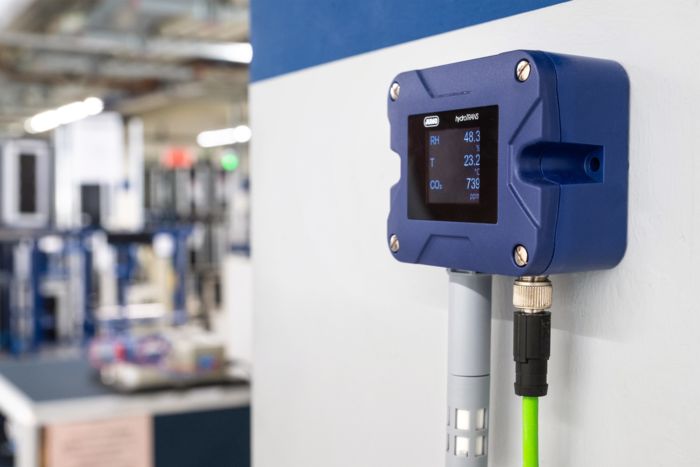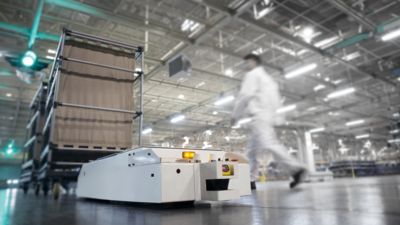Sensor technology of tomorrow for consistent communication Single Pair Ethernet: Lean communication through to the field level of automation.

Brief summary
The consistency of Ethernet for Single Pair Ethernet is essential for greater sustainability in production. The benefits result primarily from the new possibilities that simplify troubleshooting. By collecting status information, condition-based maintenance is also possible.
The example of sensor technology from JUMO illustrates how this whole host of advantages can be used to improve the OEE (Overall Equipment Effectiveness) – in other words, the overall system availability. It also makes it easier to connect to cloud-based services.

Convinced by SPE: Manfred Walter works as a product manager at JUMO in Fulda, Germany
Information generates added value
Single Pair Ethernet (SPE) has what it takes to make connections more sustainable and smarter through to the field level. It is for good reason that sensor manufacturer JUMO relies on SPE as the future-oriented communication medium for its measurement technology. The connection technology required for this comes from Phoenix Contact – and is the result of close collaboration at the project level.
“With Single Pair Ethernet, we are able to make better use of our intelligent sensors”, says Manfred Walter, product manager at JUMO. “I get real added value by being able to transmit more sensor data with SPE”. Having more data is the key to extracting useful information from it. This is simply not possible if a 4 to 20 mA sensor only transmits a bare current value – for example, as an equivalent for a temperature.

The sensors can be used to control the room climate. As here in the JUMO production facility in Fulda, Germany, the connection is slim via SPE.
Ethernet without media discontinuity
The product manager is really enthusiastic about the fact that the SPE connection finally allows sensor information to be distributed seamlessly in a system. Here, Manfred Walter has in mind the boundaries between levels within the automation pyramid, which are difficult to overcome. “At JUMO, we see consistency across all levels as a major strength”. In addition, cables can be saved because data and power are routed via the two wires of the Power over Data Line (PoDL). Essentially, SPE offers the opportunity for consistent communication from the ERP level right down to the sensor and actuator technology at the field level. “And it all works without any media discontinuity”, emphasizes Walter, as the sensor communicates consistently at all levels on the basis of Ethernet protocols.
Using SPE to combat media discontinuity in industrial communication – will this benefit lead to a rethink in the choice of connection technology at the sensor level? In Manfred Walter’s experience, customer expectations in machine building and systems manufacturing continue to be clearly price-driven. The budgets for measurement chains are very limited when planning systems. “It’s a matter of how much a measurement chain can cost and how high the additional price is for the SPE connection”. The conclusive arguments for a consistent Ethernet architecture are difficult to present, especially in standardized tendering procedures. The positive effects on the OEE are an important factor for investment decisions and can therefore best be argued directly.

Two conductors are sufficient: this is what the mating face with SPE communication looks like for JUMO
Safe monitoring
The transmission technology with SPE represents an important step on the way to convergent networks. While the Time Sensitive Network (TSN), for example, is primarily designed for time-critical tasks in the disciplines of functional safety or motion control, 5G is used for applications that require cellular communication. The same applies to WLAN 6 and 7 in the field of license-free, wireless transmission technology.
Single Pair Ethernet, on the other hand, is ideal for communication through to the field level. The common denominator for all technologies is the convergent Ethernet network – the standardized world for industrial communication. If the stakeholders in automation, electrical engineering, systems manufacturing, and machine building manage to agree on this path in the medium term, then the fieldbus wars with their industry-specific developments will finally be a thing of the past.

The data from the sensors offered via SPE is transmitted to a monitor via the dashboard in JUMO production
1,000 m with 10 Mbps
The chances of this are favorable. It is all underpinned by the general transmission performance of standard communication from the consumer market. SPE achieves as a medium for the spatially limited machine level a transmission rate of 10 Mbps on a cable length of up to 1,000 m. In comparison, I/O-Link, for example, delivers just 230.4 kbps with a maximum cable length of 20 m. Even though I/O-Link undoubtedly simplifies the connection of sensors considerably, Manfred Walter believes that this data transmission rate will no longer be sufficient for future tasks within coupled sectors.
Speaking of the future, Phoenix Contact and JUMO both see a clear trend toward convergent Ethernet networks, especially among the younger generation of specialists. “To be blunt, due to their upbringing and history, digital natives are less tolerant of the use of so many different systems in industrial automation”, says Martin Müller. The aim must be to ask more questions about what a sensor can do and what it is capable of doing beyond its own measuring range for efficient and resource-saving system operation. "We see an enormous future here", Manfred Walter also emphasizes.
Hygienically clean IP67 connector solution
Install, connect, and you’re done: With SPE connectivity, installing a JUMO sensor is a breeze. Thanks to the Ethernet layer, there is no need for gateways or time-consuming interface programming. With the aim of achieving the Single Pair Ethernet transmission distance of 1,000 m in practical applications without limiting attenuation, the connector developed by Phoenix Contact is designed in the M12 size.
“In the M8 format, we wouldn’t have had enough space to connect a two-wire data cable in 18 AWG, which is used for distances of 1,000 m”, explains Manfred Walter. The design of the connection itself is optimized for maximum robustness and hygiene. Flow and pressure sensors from JUMO’s “flowTRANS MAG H20” and “DELOS S02” series are widely used in the pharmaceutical and food industries. A high level of operational safety over long distances can only be achieved if the connections are also able to withstand demanding production processes or CiP (Clean in Place) cleaning. The Phoenix Contact solution conforms to the requirements for hygienic design and provides IP67 degree of protection.
Conclusion
Connecting sensors with SPE paves the way for incorporating additional measured variables into communication. It also opens up new possibilities for connecting sensors directly to the cloud, as the devices already have a functional gateway, eliminating the need for an additional gateway. This saves components and money. Typical areas of application that JUMO envisages for its SPE multisensor “hydroTRANS S20” include temperature, humidity, and CO₂, for example, for the monitoring of sensitive storage rooms, general monitoring tasks, and complex tasks relating to operational safety and the safety of personnel.
Connect with our experts






